



Project 949 Granit / Oscar I
Project 949A Antey / Oscar II
The Oscar-class nuclear-powered cruise missile attack submarine, which displaces more than 18,000 tons when under water, is one of Russia's largest and most capable submarines. As with earlier cruise-missile submarine, the Oscar was designed primarily to attack American aircraft carrier battle groups.
As with other Russian submarines, the Oscar features a double hull -- and inner pressure hull and an outer hydrodynamic hull, with eight inches of rubber between them to muffle sounds. American submarines have a single pressure hull, with additional hydrodynamic fairings, such as the cap that encloses the bow sonar dome. The 3.5 meter separation between the inner and outter hulls on the Oscar provides significant reserve buoyancy, and improved survivability against conventional torpedoes. These large submarines are said to be slow to dive and maneuver, though they are credited with a submerged speed of about 30 knots - sufficient to keep pace with their targets. The improved Oscar II is about 10 meters longer than the Oscar I, possibly making room for a quieter propulsion system, and feature upgraded electronic systems. The Oscar II is also characterized by a substantially enlarged fin, which should improve underwater manueverability, as well as the substitution of the Oscar-I's four-bladed propeller with a [presumably] quiter seven-blade propeller.
The Oscars are rather poorly characterized in the open literature, with substantial discrepancies in reported submerged displacement [the upper estimates are probably closer to the mark] and maximum submerged speed [reportedly classified intelligence estimates have tended upward over time. Considerable confusion also exists as to the names of some units. During the Cold War essentially no information was publicly available concerning the names of Soviet submarines, and with the end of the Cold War the Russian Navy has exibited an annoying tendency to rename ships [a very un-American practice]. And unlike the American practice, in which hull numbers are generally assigned in a consecutive numerical sequence which corresponds to the chronological sequence of construction, the pennant numbers assigned Russian submarines [eg, K-141] do not conform to an apparent set pattern.
The submarine is equipped with two dozen SS-N-19 missiles with a range of 550-kilometers -- three times as many anti-ship cruise missiles as earlier Charlie and Echo II class submarines. The missiles, which are launched while the submarine is submerged, are fired from tubes fixed at an angle of approximately 40 degrees. The tubes, arranged in two rows of twelve each, are covered by six hatches on each side of the sail, with each hatch covering a pair of tubes. The launchers are placed between the inner pressure hull and the outer hydrodynamic hull. The torpedo tubes fire both torpedoes and shorter range anti-ship missiles, and a combination of some two dozen weapons are carried.
The Project 949A submarines have a total of at least ten separate compartments, which can be sealed off from each other in the event of accidents. The compartments are numbered sequentially from fore to aft, with the two separate reactor compartments numbered V and V-bis [which is accounts for the fact that there are ten compartments, though the numbers only run through nine].
I - Torpedo room
II - Control Room
III - Combat stations and radio room
IV - Living Quarters
V and V-bis - Reactors
VI - propulsion engineering
VII - main propulsion turbines
VIII - main propulsion turbines
IX - electric motors
Access hatches are believed to be located in the 4th and 9th compartments. In common with the larger Typhoon-class ballistic missile submarine, the Oscar-class boats are reported to have an emergency crew escape capsule located in the sail.
In the 1980s the Rubin Design Bureau was responsible for developing a number of third generation nuclear submarines with cruise missiles, including Projects 949 ("Granit", "Oscar I") and 949A ("Antey", "Oscar II"). The Bureau took the lead in using naval cruise missiles, designing the first cruise missile nuclear submarine -- Project 659 ("Echo I"), then Project 675 ("Echo II") and related modifications.
To manage the impact of its resource problems, the Russian Navy, in the early 1990�s, made a series of hard choices aimed at preserving its core submarine force capabilities. These included early retirements of older and less capable units, strict controls on operating tempo, and focused maintenance on its best submarines. The first Oscar I units were decommissioned in 1996, though the Russian Navy continued to invest in new construction. In the late 1990s it completed several new submarines of the larger third generation Oscar II SSGN.
Considering the importance of the Oscar II submarines for the Russian Navy, the level of confusion concerning the designations and status of the units of this class verges on the astonishing. There is almost complete disagreement among all authoritative sources concerning the correlation between pennant number, name, construction sequence and current status. Allowing for the unavoidable uncertainties inherent in assigning "commissioning" dates, most sources are in general agreement as to the unit chronology and pennant number chronological sequence of the first ten units, through K-141 Kursk. There is however, rather general disagreement among sources as to the names associated with these units, and the status of particular units.
All sources agree that at least eleven of the Oscar II submarines were built between 1985 and 1999 at the Sevmash yard in Severodvinsk. The status of a twelfth Oscar-II is somewhat uncertain, as some sources suggest it was comissioned in late 1999, while most agree that outfitting was suspended after it was launched [sometime in the 1998-1999 timeframe]. Some Western sources suggest that construction was suspended on a thirteenth unit, and that as many as 15 units of the Oscar II class were planned, but Russian sources maintain that the Oscar-II class was never intended to consist of more than twelve vessels.
A fourth-generation follow-on to the Oscar was planned, but reduced defense spending forced the cancellation of the project.
Sources generally agree that at least two and possibly as many as three of the initial nine Oscar II units were inactivated in the late 1990s, and as of mid-2000 were laid up awaiting disposal. Considerable confusion surrounds the identity of the third and fourth units -- Krasnoyarsk] was reportedly deactivated in 1998, but sources differ as to whether this name was assigned to K-119 or K-173.
The active Northern Fleet units are homeported at the Zapadnaya Litsa base (Bolshaya Lopatka). The disposition of units between the Northern and Pacific Fleets is uncertain. As of September 1997 Bellona placed six units in the Northern Fleet, four in the Pacific. As of September 2000 the warships1.com analysis also placed 4 units in the Pacific Fleet, and the remaining 6 in the Northern Fleet. However, World Navies Today reports that ten active units [as of late 2000] are evenly divided between the two fleets [but the unit list seems rather unreliable, casting doubt on this assessment]. The two sources appear to disagree on the location of K-119 Voronezh.
On 26 January 1998 a moored nuclear-powered Oscar II submarine suffered a cooling system accident. During routine tests aboard a cooling system pipe broke, releasing ammonia and nitrogen gas into the compartment. A total of 5 crew members were injured, one of whom, a Captain of the 3rd Rank, died two days later. The Oscar II submarine was reportedly the K-512 St.Georgy Pobeditel [formerly named Tomsk]. This eleventh unit of the 'Oscar II' SSGN class had been launched in July 1995 despite irregular materiel and component delivery problems.
In 1994 an Oscar submarine conducted operations off the East Coast of the United States. In July 1997 when the Oscar II submarine K-442 Chelyabinsk [aka Pskov] shadowed several US aircraft carriers off Washington state. The Tomsk transitted to the Pacific under ice after being commissioned on 28 February 1997, and arrived at Petropavlovsk-Kamchatskiy on 24 September 1998. This brought the Pacific Fleet class inventory to seven, with four others in the Northern Fleet. In February 1999 an Oscar-class submarine was observed monitoring a NATO exercise off the coast of Norway. In August 1999 NATO sonar detected the presence in Western
Atlantic waters of a Russian Oscar class submarine belonging to the northern fleet,
based in the Arctic ports. In the mid-1999 an Oscar II-class submarine sailed from northern Russia to the Mediterranean, the first Russian SSGN patrol in the Mediterranean in a decade. It then sailed on to areas off the eastern United States. In early September 1999 the crew of the Jose Maria Pastor, a fishing trawler registered in Almeria [southeastern
Spain] reportedly snagged an Oscar submarine in its nets. The incident occured some 27 miles (50 kilometers) from the Tarifa coast (Cadiz Province), and continued for over half an hour before the submarine broke free. Another Oscar II deployed from the Russian Far East, sailing to the area around Hawaii before arriving in waters off San Diego by October 1999. It reportedly spent a week following the aircraft carrier USS John C. Stennis and the amphibious landing ship Essex.
K-141 Kursk
On or about 12 August 2000, the tenth unit of the Oscar-II class, the K-141 Kursk, sank about 100 miles from the Russian port of Murmansk. At the time the boat was participating in the fleet's major summer exercises, involving about 30 other vessels. The Kursk apparently sank quickly, and did not launch distress buoys. The submarine was not carrying any nuclear weapons at the time, and there was apparently no immediate danger of radiation leaks. Considerable confusion surrounded initial reports, though apparently the Kursk shut down its two nuclear reactors after it was crippled. Although Russian Navy commander Adm. Vladimir Kuroyodev stated that there were "signs of a big and serious collision," subsequent reports cast doubt that the sub was damaged in a collision. The US Department of Defense stated that there was " no indication that a US vessel was involved in this accident." By 15 August it was generally believed that the Kursk had been damaged by an explosion on board, probably in the torpedo room.
Initial reports suggested that at least some of the crew were alive and communicating through rhythmic tapping on the hull. Rescue submarines that rushed to the Kursk reportedly found it damaged but resting upright on the seabed, at a depth variously reported as between 350 feet and 500 feet of water. Subsequent reports suggested that the submarine was listing, perhaps as much as sixty degrees. According to initial reports, as of Monday 14 August 2000 at least one rescue craft, the Kolokol, was said to be feeding power and oxygen to the Kursk. Communication links with the boat's captain, Gennady Lyachin, were reportedly restored after a day of radio silence. However, subsequent reports indicated that these initial reports were incorrect, and overly optimistic. Admiral Kuroyedov initially expressed doubts about the possiblity of rescuing the crew, stating "the chances for a positive outcome are not very high." The Russians had two India-class rescue submarines, each of which carried a pair of small rescue submarines which could reach a depth of 2,275 feet. However, these submarines and their rescue capabilities were apparently discarded by the Russians in 1995 as a cost-savings measure.
Rescue efforts centered on attempts to attach equipment to provide oxygen and restore electric power to the submarine. As of 15 August a first attempt to lower a diving bell to the submarine had failed, and a second attempt was launched soon thereafter. The two attempts on Tuesday to reach the Kursk were frustrated by of poor underwater visibility and 12-foot high waves. Rescue workers failed in efforts to maneuver a robotic remotedly operated vehicle onto an emergency hatch on the submarine.
By Wednesday, while Russian experts were still optimistic about the rescue operation,
Russian President Putin termed the situation with wrecked sub "critical". The weather had worsened in the Barents Sea, while the Bester capsule with divers aboard was used for the first time Rrescue ships tried twice more to lower a diving bell to dock with the Kursk, but each time the operations had to be aborted because of rough seas, strong currents, and poor underwater visibility. Rescue efforts continued despite the fact that one of the three rescue capsules used to reach the stranded sub was damaged in the storm. The Russian military consulted NATO experts on submarine rescue, and Russia asked Britain and Norway to help the rescue effort. Britain sent three aircraft with crew and equipment, and the first plane loaded with a British rescue vessel landed in Norway late Wednesday [Moscow time]. The British mini-submarine may be transported to Russia by Saturday.
On Thursday 17 August it was reported that US surveillance ships in the area at the time of the accident heard two explosions on 12 August, the second much stronger than the first. The Russian navy was reported to be studying video footage showing massive damage to the first and second compartments in the submarine's bow. A Navy spokesman said the video showed extensive damage from the top to the back fin. The periscope was also still up, indicating the ship sank so fast the crew did not have time to react. Russia's Deputy Prime Minister Ilya Klebanov said films taken of the Kursk indicated extensive
damage to the ship's bow that he said was caused by a collision with an unknown object.
By Friday it was reported that the submarine was lying at an angle of no more than 20 degrees from vertical, rather than the 60 degress previously reported, and at a depth of a little more than 100 meters. The depth and the angle are were said to be well within the operating limits of th British LR5 rescue craft.
It was initially estimated that the air on the K-141 Kursk submarine would run out by Friday 18 August 2000. As of Friday it was officially estimated it could last another five days. Contrary to most news reports, the problem was not a lack of oxygen for the crew to breath in, but rather the buildup of the carbon dioxide that they would breath out. Over time, this carbon dioxide would build up to a level that would kill any crew members who survived the initial accident. The oxygen limit is about 0.1 atm and the Carbon dioxide limit is time dependent, but somewhere between 0.03 and 0.06 atm. Respiration produces (roughly) 1 molecule of carbon dioxide for each molecule of oxygen consumed. This suggests that, starting with 0.21 atm of oxygen, the oxygen partial pressure will still be 0.15 atm even when 0.06 atm of carbon dioxide is present. [see the NOAA Diving Manual for details].
While some Russian Navy officials maintained that some crew members remained alive and were sending an SOS message by banging against the submarine's hull, other officials said there had been no communication and that the crew might already be dead.
On 21 August Chief of staff of the Russian Northern Fleet Mikhail Motsak pronounced the Kursk flooded and its whole crew dead. Admiral Motsak said a Norwegian-led team of divers was videotaping the interior of the rear compartment after successfully breaking in through damaged escape hatches.
On 01 September 2000 an agreement was reached on the technical and organizational aspects of the international effort to lift to the surface the bodies of the crewmen of the Kursk. The Norwegian Stolt Offshore company received blueprints representatives of the naval design center which designed the sunken submarine that showed where deep water frogmen may enter the boat. A team of international and Russian divers planned to cut holes in the Kursk�s hull to pull out the remains of the 118 seamen who died. The operation was scheduled to begin in October 2000.
There was no chance of quickly salvaging the Kursk submarine, since September is the month when storms start raging in the Barents Sea, which would make such impossible. At best the salvaging operation could be carried in 2001. Neither the Russian submarine base at Vidyaevo, nor any western base have hoists capable of salvaging such a large vessel the Kursk submarine, or even moving it to a shallow place closer to the coast. It would take several months only to build such a device. Another priority on the agenda is the salvaging of the submarine and taking it to shallow waters. The Norwegian Stalled Offshore Company has given its consent to participate in the salvage effort.
On 06 September 2000 Russian President Vladimir Putin was reported to have said that the 118 sailors aboard the submarine Kursk probably died quickly after it sank, and that they never sent any signals from the distressed sub after it went down. At the time of the accident, conflicting reports from some Russian naval officials indicated that survivors were tapping on the ship's hull. But Putin said that the signals came from "a mechanical device on board" that went off automatically.
There are several versions of the reasons for the disaster. According to Vice-premier Ilya Klebanov, the first version is that of an underwater collision with a foreign vessel. Ilya Klebanov who heads the commission to investigate the case described as the second version a possibility that the submarine hit a German mine left over from the time of the Second World War. The third version, the Vice-premier believed, could be an emergency situation in the submarine's torpedo compartment. According to Ilya Klebanov, the majority of the crew died during the first seconds of the disaster.
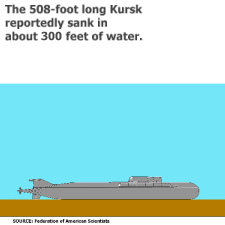

Specifications
|
|
|
949 (Oscar-I)
|
949A (Oscar-II)
|
|
Displacement (tons):
|
12,500 surfaced
15,500 - 22,500 submerged
|
13,400 - 14,700 surfaced
16,400 - 24,000 submerged
|
|
Speed (kts):
|
32 knots dived
16 kts surfaced
|
32 knots dived
16 kts surfaced
|
|
Dimensions (m):
|
143.0 meters long
18.2 meters beam (20.1 with stabilizers)
9.0 meters draft
| 154.0 meters long
18.2 meters beam
9.0 meters draft
|
|
Propulsion
|
2 VM-5 190 MWt pressurized-water nuclear reactors (OK-650b)
2 steam turbines - 90,000 shp
|
|
Propulsion
|
2 4-bladed propellers
|
2 7-bladed propellers
|
|
Endurance:
|
50 days
|
|
Diving depth:
|
300-600 meters [by various estimates]
|
|
Crew :
|
94 total
|
|
Armament:
|
24 - SS-N-19 / P-700 Granit
24 - torpedoes/tube-launched weapons
4 - 533 mm tubes - SS-N-15 Starfish / 82-P missiles or torpedoes
4 - 650 mm tubes - SS-N-16 Stallion / 85-P missiles or torpedoes
|
| Electronics
|
Radar
Snoop Pair or Snoop Half Surface Search
Rim Hat intercept array
Sonar
Shark Gill (MGK-503) hull mounted
Shark Rib flank array
Mouse Roar MG-519 Hull mounted
Pelamida towed array
2 periscopes
|
Class Listing
|
| Boat | Shipyard | Fleet | Chronology | Notes |
|---|
| NO. | Name | Laid Down | Launched | Comm. | Stricken |
|
Project 949 ("Granit" type), NATO code "Oscar I"
|
| 1 | K-525 | Arkhangelsk | SY 402 | NOR | 1978 | 04/**/1980 | 1982 | 1996 |
12/30/80 named "Minsky Komsomolets"
1991 renamed
1996 deactivated
2000 to be dismantled at Sevmash
|
| 2 | K-206 | Murmansk | SY 402 | NOR | 1980? | 12/**/1982 | 1983 | 1996 |
1991 named
1996 deactivated
2000 to be dismantled at Sevmash |
|
Project 949A ("Antey" type), NATO code "Oscar II"
|
| 1 | K-148 | Orenburg | SY 402 | NOR | ---------- | 08/**/1985 | 07/**/1986
12/**/1986 | ?? 1998 |
ex-Krasnodar [name as of 1995]
ex-Vologda
2000 probably active
2000 laid up awaiting disposal ?? |
| 2 | K-132 | Irkutsk | SY 402 | PAC | ---------- | **/**/1986
03/**/1986 | **/**/1987
01/**/1987 | ? 1998 | (name also reported as "Belgorod")
2000 in reserve
2000 laid up awaiting disposal ? |
| 3 | K-119 | Voronezh | SY 402 | NOR
PAC ? | ---------- | **/**/1986
12/**/1987 | **/**/1988
12/**/1988 |
| (name also reported as "Krasnoyarsk"
"Tambov" or "Chel'yabinsk")
2000 active
|
| 4 | K-173 | Krasnoyarsk | SY 402 | NOR | ---------- | **/**/1987
01/**/1989 | **/**/1988
12/**/1989 | ? 1997-8 | (name also reported as "Veronesh")
(name mis-reported as "Chelyabinsk")
1997-8 deactivated
2000 laid up awaiting disposal ? |
| 5 | K-410 | Smolensk | SY 402 | NOR | ---------- | **/**/1988
12/**/1989 | **/**/1990
12/**/1990 | | 2000 active |
| 6 | K-442 | Chelyabinsk | SY 402 | PAC | ---------- | **/**/1989
01/**/1990 | 12/29/1990
01/**/1991 | | (name also reported as "Pskov")
(name mis-reported as "Tomsk")
2000 active |
| 7 | K-456 | Viliuczinsk | SY 402 | PAC | ---------- | **/**/1990
12/**/1991 | **/**/1991
11/**/1992 | | (ex-"Kasatka", possibly "Tambov")
09/**/1993 to Pacific Fleet
2000 active |
| 8 | K-266 | Orel | SY 402 | NOR | ---------- | 01/**/1992
05/22/1992 | 12/**/1992
01/**/1993 | | (ex-"Severodvinsk")
2000 active |
| 9 | K-186 | Omsk | SY 402 | NOR | ---------- | 05/08/1993 | 10/27/1993
12/15/1993 | | (possibly renamed
"Petropavlosk Kamchatsky")
2000 active |
| 10 | K-141 | Kursk | SY 402 | NOR | 1992 | 05/**/1994 | 10/**/1994
12/30/1994
01/20/1995 | 8/12/2000 | |
| 11 | K-512 | St.Georgy Pobeditel | SY 402 | PAC | ---------- | 07/18/1995
07/18/1996 | 02/28/1997
12/31/1997 | | (ex-"Tomsk")
08/1997 operational
01/26/1998 cooling system accident
2000 active |
| 12 | K-530 | Belgorod | SY 402 | | ---------- | 05/**/1998
08/**/1999 | ???? | | (name also reported as "Pskov")
2000 construction suspended??
|
| 13 | K-139 | Pskov? | SY 402 | | ???? | ???? | ---------- | | [?? construction suspended ??]
|
| 14 | K-___ | | SY 402 | | ???? | ---------- | ---------- | | [?? cancelled ??]
|
| 15 | K-___ | | SY 402 | | ???? | ---------- | ---------- | | [?? cancelled ??]
|

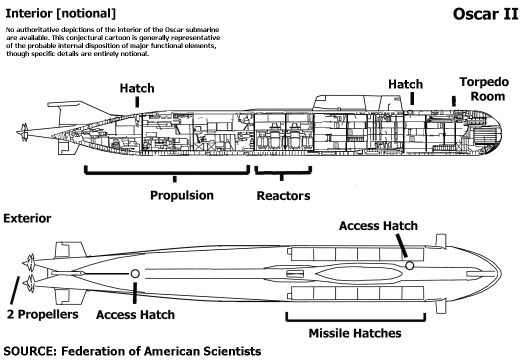


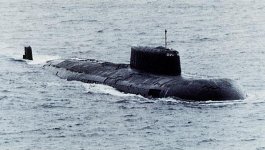
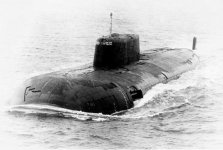
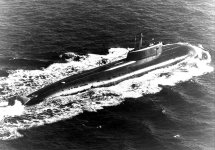
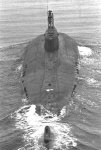
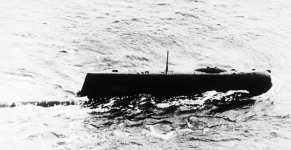
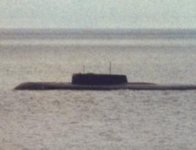
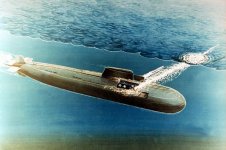
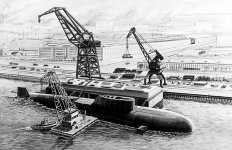
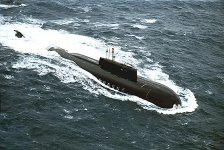
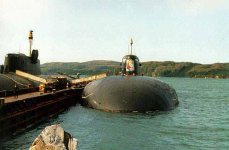
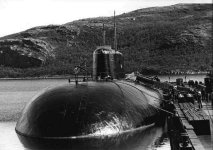
Sources and Resources
- Pr. #949A 'Antey' NATO Code 'Oscar II' @ warships1.com
- Project 949 (Granit) - Oscar-I @ bellona
- Project 949 A (Antey) - Oscar-II @ bellona [unit list seems somewhat unreliable]
- SSGN Oscar II Class (Project 949.A); (Kursk) - Cruise Missile Submarine @ naval-technology.com
- Russian Submarines @ World Navies Today [unit list seems rather unreliable]
- Oscar I and II classes @ USNI Military Database
- Russian Submarine List @ Steel in the Deep Submarine Site
- Sunken Russian Submarine Yahoo Full News Coverage
- Crippled Nuclear Sub @ Excite News Tracker
- RUSSIAN SUBMARINE K-141 (KURSK) DISASTER @ Central Naval Museum
- Accidents and incidents
@ Bellona Foundation
- The Scramble to Save a Sunken Russian Crew @ ABC News
- Race to save stricken sub @ BBC
- Kursk SSGN Accident @ Moscow Institute of Physics and Technology, Center for Arms Control, Energy and Environmental Studies
- The Kursk Accident @ Center for Nonproliferation Studies
- Russian Submarine Page @ Russia Today
- Latest Headlines from ITAR-TASS
- Seismic records from the explosion onboard the Russian sub Kursk by Terry Wallace, University of Arizona - The explosion on the Kursk was approximately .25 to .75 tons.
- Kursk Disaster Linked To Torpedo Explosions, RFE/RL Newsline, Vol. 5, No. 33, Part I, 16 February 2001 -- The government commission investigating the August 2000 Kursk submarine disaster has found that torpedo explosions were responsible for the sinking
- Torpedo Explanation For 'Kursk' Confirmed, RFE/RL Security Watch, Vol. 1, No. 21, 11 December 2000 -- "Komsomolskaya pravda" reported on 5 December that it had obtained additional proof that the "Kursk" submarine sank because of the explosion of defective torpedoes.
- Russia / Kursk Letter, Voice of America, 10 November 2000 -- The mission to recover the remains of crewmen who died aboard the sunken nuclear submarine "Kursk" has uncovered a log book and two notes written by Russian submariners - notes that have helped revive public criticism over the military's slow response to the August 12th disaster.
- Klebanov Says Divers Found Sub's Log Book, RFE/RL Newsline, Vol. 4, No. 219, Part I, 10 November 2000 -- Deputy Prime Minister Ilya Klebanov, who heads the government commission investigating the causes of the sinking of the "Kursk" nuclear submarine, said officials are studying the vessel's log book that divers found in the fourth compartment while seeking to recover bodies of the crew
- Klebanov Says New Evidence Supports 'Kursk' Collision Theory...As Second Note Found On Submariner's Body, RFE/RL Newsline, Vol. 4, No. 218, Part I, 9 November 2000 -- Deputy Prime Minister Ilya Klebanov, who heads the government commission investigating the causes of the sinking of the "Kursk" nuclear submarine, told journalists on 8 November that pictures taken of the vessel during the recent recovery operation support the theory that the "Kursk" collided with another vessel.
- Russia / Kursk, Voice of America, 07 November 2000 -- The Russian Navy has halted recovery operations on the sunken nuclear submarine, the Kursk.
- Divers Enter Sunken Sub's Fourth Compartment...As Navy Commander Sticks To Foreign Sub Theory, RFE/RL Newsline, Vol. 4, No. 215, Part I, 6 November 2000 -- Vladimir Kuroedov told Interfax on 3 November he is "certain" that the "Kursk" disaster was caused by a collision with a foreign submarine.
- Divers Begin Work On Entering Sub's Fourth Compartment, RFE/RL Newsline, Vol. 4, No. 214, Part I, 3 November 2000 -- Russian Navy Commander Vladimir Kuroedov on 2 November halted work on the third compartment of the sunken "Kursk" nuclear submarine, deeming it too dangerous for divers to enter, Interfax reported.
- Divers Complete Cutting Hole Into 'Kursk' Third Compartment, RFE/RL Newsline, Vol. 4, No. 213, Part I, 2 November 2000 -- Russian and Norwegian divers have finished cutting a hole into the third compartment of the "Kursk" nuclear submarine, which sank during maneuvers in the Barents Sea in August, a Northern Fleet spokesman told Russian Television on 2 November.
- Russia Sub, Voice of America, 30 October 2000 -- 12 bodies have been removed from the wreck so far.
- Russia - Sub, Voice of America, 27 October 2000 -- In Russia, details are beginning to emerge about what the final moments were like for sailors aboard the nuclear submarine Kursk, which sank in the Barents Sea two months ago. The Russian navy says fire swept through the vessel, and at least some of the (118) victims died of burns and other injuries.
- Russia sub, Voice of America, 28 October 2000 -- Russian and Norwegian divers resumed work Saturday at the wreck of the sunken nuclear submarine Kursk after more than a day's delay due to bad weather.
- Divers Recover Four Bodies From 'Kursk' Wreck...As Note Reported Found On One Crew Member, RFE/RL Newsline, Vol. 4, No. 208, Part I, 26 October 2000 -- Following the cutting of a hole in the hull of the "Kursk" nuclear submarine (see "RFE/RL Newsline," 25 October 2000), Russian divers recovered four bodies from the vessel before worsening weather conditions forced them to suspend the recovery operation on the morning of 26 October.
- Russia Sub, Voice of America, 26 October 2000 -- A note found on one of four bodies recovered from the sunken nuclear submarine Kursk confirms that some crew members survived the blast that sent the vessel to the bottom of the Barents Sea last August.
- Divers Complete Entry Hole In 'Kursk' Submarine, RFE/RL Newsline Vol. 4, No. 207, Part I, 25 October 2000 -- Russian and Norwegian divers have completed a hole in the hull of the sunken "Kursk" nuclear submarine that will allow Russian divers to enter the vessel in search of bodies of the 118 crew members.
- Russia / Sub, Voice of America, 25 October 2000 -- Three bodies have been recovered from the wreck of the sunken nuclear submarine Kursk. A Russian diver entered the vessel after a laborious process of cutting through the double hull.
- 'Kursk' Recovery Operation Resumes Following Storm , RFE/RL Newsline Vol. 4, No. 206, Part I, 24 October 2000 -- The operation to recover at least some of the bodies of the sunken "Kursk" nuclear submarine was halted in the evening of 23 October as weather conditions at the disaster site worsened.
- Divers Begin Work To Retrieve 'Kursk' Crew Bodies , RFE/RL Newsline Vol. 4, No. 205, Part I, 23 October 2000 -- Russian and Norwegian divers, working in shifts over the past weekend, have cut through the outer hull of the sunken "Kursk" nuclear submarine and removed an industrial rubber coating between the outer and inner hulls.
- Russia - Sub, Voice of America, 21 October 2000 -- Divers have descended to the wreck of the Russian nuclear submarine Kursk, which sank in the Barents Sea in August. They are preparing the way for a larger operation to recover the bodies of crewmen who died.
- Navy Commander Warns 'Kursk' Recovery Operation May Be Called Off...As Captain's Widow Resigns From Commission Helping Victims' Families, RFE/RL Newsline Vol. 4, No. 204, Part I, 20 October 2000 -- Following contradictory comments by Russian officials over the prospects for recovering at least some of the bodies of the 118-strong crew of the sunken "Kursk" nuclear submarine (see "RFE/RL Newsline," 19 October 2000), the Navy commander has suggested that the recovery operation may not take place.
- IS GOVERNMENT STALLING OVER 'KURSK' RESCUE OPERATION? , RFE/RL NEWSLINE Vol. 4, No. 203, Part I, 19 October 2000 -- Colonel General Valerii Manilov, first deputy chief of the Russian General Staff, was quoted by Interfax on 18 October as suggesting the government may reverse its decision to recover the bodies of at least some of the 118 crew members of the "Kursk" nuclear submarine, which sank in the Barents Sea in August during maneuvers.
- RUSSIA / PARLIAMENT / KURSK, Voice of America, 15 September 2000 -- The Russian official in charge of the investigation into the sinking of the nuclear submarine Kursk faced a barrage of criticism Friday as he addressed Russia's lower house of parliament, the Duma.
- RUSSIA / NUCLEAR, Voice of America, 12 September 2000 -- The Russian government says that next month deep sea divers will begin recovering the bodies of the 118-crewmen who died aboard the sunken nuclear submarine Kursk.
- PUTIN/KURSK, Voice of America, 09 September 2000 -- Russian President Vladimir Putin acknowledges he made a mistake last month by failing to rush back to the Kremlin from his southern vacation to deal with the "Kursk" nuclear submarine disaster.
- RUSSIA SUB, Voice of America, 08 September 2000 -- A German newspaper is reporting that a missile fired by a Russian warship hit and sank the Russian submarine Kursk last month.
- RUSSIA / SUB, Voice of America, 30 August 2000 -- Russian officials say efforts to recover the remains of 118-seamen who died aboard the nuclear submarine Kursk will begin by the end of September.
- RUSSIA SUB Voice of America 24 August 2000 -- Russia's top prosecutor says he is opening a
criminal investigation into the sinking of the Kursk
submarine
- RUSSIA SUB / MEDIA ROLE
Voice of America 24 August 2000 -- The Kursk nuclear submarine disaster has widened the gap
between the government's reliance on secrecy and
society's push for openness.
- RUSSIA SUB Voice of America 23 August 2000 -- Russian President Vladimir Putin has promised
compensation to relatives of the 118 sailors who died
aboard the Kursk nuclear submarine more than a week
ago.
- RUSSIA SUB / PUTIN Voice of America 23 August 2000 -- President Vladimir Putin says his defense
minister and two senior naval officials are
offering to step down to atone for the loss of
the submarine.
- RUSSIA SUB Voice of America 22 August 2000 -- Russian President Vladimir Putin is visiting
the home base of the navy's Northern Fleet to pay
tribute to 118 sailors who died aboard the nuclear
submarine Kursk.
- RUSSIA SUB / IMPACT Voice of America 22 August 2000 --
Only a few weeks ago, President Putin hailed the
nuclear fleet as the symbol of Russia's power. Navy
officials want to blame the Kursk accident on a
collision, but independent experts suspect an
explosion in the submarine's torpedo compartment.
-
SECRETARY-GENERAL FOLLOWING WITH SORROW TRAGIC DEVELOPMENTS IN BARENTS SEA AFTER SINKING OF
SUBMARINE KURSK , UN Press Release, 21 August 2000 -- The Secretary-General has been following with sorrow the tragic developments in the Barents Sea following the sinking of the submarine Kursk...
- Russia's Handling of Sub Accident, U.S. DEPARTMENT OF STATE
DAILY PRESS BRIEFING, 21 August 2000 -- ...has the State Department got any reflections
on how the Russian government handled the matter and will it have
any effect on US-Russian relations?
- RUSSIA SUB Voice of America 21 August 2000 -- Russia's attempts to rescue sailors aboard a cripple submarine are over. Norwegian divers say there are no survivors on the sunken Kursk nuclear submarine.
- RUSSIA SUB Voice of America 21 August 2000 --
Norwegian divers have forced open the outside hatch and found the escape compartment inside flooded,
with no signs of life. The next step is to pry open the inner hatch to let rescuers get inside the main
part of the submarine.
- RUSSIA SUB Voice of America 20 August 2000 --
A spokesman for the Norwegian military denied Russian reports that a man had been found inside the air lock below the hatch.
- RUSSIAN SUB Voice of America 20 August 2000 --
Russian T-V reported Sunday that divers suspect a crew member of the damaged Russian submarine
Kursk may be trapped in the air lock inside the rear escape hatch.
- RUSSIAN SUB UPDATE Voice of America 20 August 2000 -- Norwegian reconnaissance team confirms earlier reports that the rear cargo hatch is badly damaged and so is much of the rest of the submarine.
- RUSSIAN SUBMARINE Voice of America 20 August 2000 --
British and Norwegian teams have joined Russian rescue operations around a damaged submarine.
Surveillance cameras were lowered to the wrecked submarine first.
- RUSSIAN SUB Voice of America 20 August 2000 -- British and Norwegian teams have joined Russian rescue operations around a damaged submarine.
Surveillance cameras were lowered to the wrecked submarine first.
- RUSSIAN SUB Voice of America 19 August 2000 -- Russia's navy now says there is little hope of finding any survivors on the nuclear submarine Kursk. The absence of any more S-O-S tappings since Monday probably means they had crossed the
critical survival threshold.
- RUSSIAN SUB Voice of America 19 August 2000 -- British and Norwegian rescue teams are racing toward the accident site in the Barents Sea.
- Defense Secretary Cohen's comments on the Kursk accident, DoD News Briefing, 18 August 2000
- Kursk Submarine Disaster: Russian Elite Scored, Democracy Tested, U.S. Department of State Foreign Media Reaction Reports, 18 August 2000 -- Commentary from around the world on the Russian submarine accident.
- Giant blast may have killed half of doomed sub's crew
Ian Thomas DAILY MAIL (London) August 18, 2000 - The biggest threat to them would have been carbon dioxide poisoning or exposure. 'Any survivors will not run out of oxygen, they will suffocate due to a build up of excessive levels of carbon dioxide,' said John Pike, of the Federation of American Scientists.
- Submarine rescue offer extended, says SACLANT, Navy Wire Service, 18 August 2000 -- Officials from NATO have extended an offer of
assistance to the Russian government regarding the submarine
rescue operation ongoing in the Barents Sea.
- DSRVs and SRCs spell "rescue" for stranded submariners, Navy Wire Service, 18 August 2000 -- Report on the US Navy's submarine rescue equipment.
- The Russian submarine situation: A statement by Vice Adm. Grossenbacher, Navy Wire Service, 18 August 2000 -- A statement
by the commander of the US Navy's Submarine Force Atlantic
- Two or More Explosions By David Ruppe ABCNews.Com 18 August 2000 -- The first, smaller reading �certainly would be consistent with what you might expect from either a torpedo or cruise missile warhead exploding,� says John Pike, of the Federation of American Scientists, adding, �it would not exclude bumping in to an old WWII sea mine.�
- RUSSIAN SUB Voice of America 17 August 2000 -- Russian officials now say it was a collision that sank the ship in the northern Barents Sea. Russian officials at first said the oxygen supply aboard the Kursk would run out by now (Friday). Then they estimated it could last another five days.
- U.S. DEPARTMENT OF STATE DAILY PRESS BRIEFING, Philip T. Reeker, Deputy Spokesman, 17 August 2000 -- QUESTION: Do you have any requests from the Russians regarding
the sub yet? Where do things stand?
- DoD News Briefing, 17 August 2000 -- United States, heard no form of communication. Our source of information on that has come from Russian officials and Russian press reporting that have discussed and alluded to the tapping over the past couple of days.
- RUSSIA / SUB Voice of America 17 August 2000 -- A Navy spokesman says film taken of the wrecked submarine shows extensive damage from the top to the back fin. The periscope was also still up, indicating the ship sank so fast the crew did not have time to react.
- RUSSIA / SUB Voice of America 17 August 2000 -- Overnight attempts to save the crew and submarine failed because of strong currents and poor visibility. British equipment and Norwegian deep-sea divers are not expected to reach the accident site before late Friday or Saturday.
- RUSSIA SUB - SURVIVORS TALK Voice of America 17 August 2000 -- John Pike, a defense analyst at the Federation of American Scientists,
thinks all this talk about surviving cold temperatures and little oxygen may be beside the point.
- Sub's reactors not viewed as threat to environment By DALE EISMAN The Virginian-Pilot August 17, 2000 - Assuming that the reactor containment mechanisms of the Kursk remain intact, the possibility of radioactive release ``is a long-term object for study rather than a near-term object of fear,'' said John Pike of the Federation of American Scientists.
- RUSSIAN / SUB Voice of America 16 August 2000 -- Russian officials say there has been no sign of life on board the submarine for several hours, but that did
not mean there were no survivors.
- RUSSIAN SUB / MILITARY Voice of America 16 August 2000 -- Less than one-month ago, President Vladimir Putin proclaimed Russia's navy as the symbol of a strong
Russian state and a pillar of its defense capabilities. The untimely Kursk disaster has seriously tarnished that image.
- JANES / RUSSIAN SUB Voice of America 16 August 2000 -- Military expert Paul Beaver of "Jane's Defense Weekly" believes the chances of saving the lives of
the sailors on board the crippled Russian submarine at the bottom of the Barents Sea are slim at best.
- RUSSIAN SUBMARINE: BRITISH RESCUE TEAM LEAVE UK FOR NORWAY 16 August 2000 - The Rescue Vehicle, LR5 and a Remote Operated Vehicle - Scorpio, together with crews and support staff numbering over 20 personnel, have been loaded onto a chartered Antonov transport aircraft.
- CLINTON-PUTIN, Voice of America, 16 August 2000 -- President Clinton - in a 25-minute telephone
conversation with Russian President Vladimir Putin -
has reiterated the United States' readiness to help in
the rescue of crewmen aboard the sunken Russian
submarine in the Barents Sea.
- CLINTON AGAIN OFFERS U.S. HELP IN RUSSIAN SUBMARINE RESCUE EFFORT, USIA Washington File, 16 August 2000 -- President Clinton has again offered U.S. assistance to help Russia
rescue its sailors trapped in a submarine in the Barents Sea northeast
of Finland.
- Pentagon Says U.S. Not Asked For Help By Ward Sanderson, European Stars and Stripes August 16, 2000 -- The Pentagon on Tuesday said Russians have not asked for help in rescuing the more than 100 crew members stranded inside their sunken submarine, the Kursk.
- Rescue Attempts Fail as Russia Calls for Aid By Daniel Williams Washington Post Wednesday, August 16, 2000 - At least three attempts by mini-submarines to dock with a rear escape hatch failed overnight and today. A fourth reportedly was underway.
- Russia: U.S. Offers Help To Rescue Submarine By Frank T. Csongos (RFE/RL) 16 August 2000 - U.S. experts said whatever sank the submarine Kursk, which was designed to withstand a torpedo attack with its double-layer hall, had to be massive. John Pike of the Federation of American Scientists said the 13,900-ton submarine was designed to be hard to sink.
- Plight of Russian vessel Kursk brings memories of horror to the surface for long-retired sailors By Bill Nichols and Andrea Stone USA TODAY
16 August 2000 - ''It's kind of like the Apollo 13 of submarines. Spaceships and subs have one thing in common: Either everything's working OK, or everyone's dead, and there's not that much in between,'' says John Pike, a defense analyst at the Federation of American Scientists.
- Time running out for 116 men By STEVEN MUFSON Syndey Morning Herald 16/08/2000 - Mr John Pike, of the Federation of American Scientists, said: "Obviously something seriously is wrong, because this is a big, robust sub that was designed to be hard to sink."
- Russian Sub Stranded on Sea Bottom By Daniel Williams Washington Post August 15, 2000 - The submarine Kursk sank about 100 miles from the Russian port of Murmansk during a naval exercise that involved about 30 vessels. Two U.S. Navy submarines were operating in the area at the time of the accident, and one reported hearing an explosion at the site Saturday. The Kursk reportedly shut down its two nuclear reactors after it was crippled. Crewmen appeared to be alive and were communicating through rhythmic tapping on the hull. Small rescue submarines circling the Kursk found it damaged but sitting straight on the seabed.
- Aboard Kursk, 'Submariner's Worst Nightmare'; by Steven Mufson and Kathy Sawyer, Washington Post August 15, 2000 - "Obviously something seriously is wrong, because this is a big, robust sub that was designed to be hard to sink," said John Pike of the Federation of American Scientists. "They didn't just stub their toe."
- 116 Russians trapped in submarine By Marcus Warren in Moscow, Ben Fenton in Los Angeles and Michael Smith, Defence Correspondent, [London] Telegraph Tuesday 15 August 2000 -- John Pike, of the Federation of American Scientists, an independent group, said: "It sounds as if it suffered a combination of human error and mechanical failure. Russian subs are poorly maintained and rarely go to sea. Most of their units have spent most of the past decade in port."
- RUSSIA / SUB Voice of America 15 August 2000 -- Bad weather is hindering efforts to rescue 116 Russian sailors trapped aboard a crippled nuclear submarine in the Russian Arctic.
- RUSSIA / SUB Voice of America 15 August 2000 -- Russia's Itar-Tass news agency says a first attempt to lower a diving bell to the submarine failed. A second attempt was launched soon after.
- RUSSIA / SUB Voice of America 15 August 2000 -- A special British rescue team is getting ready to aid in efforts to save the crew of a stricken Russian submarine.
- DoD News Briefing Tuesday, August 15, 2000 - 1:35 p.m. EDT Presenter: Rear Adm. Craig Quigley, DASD PA Q: And one other sort of operating question. If the submarine is in fact at a 60-degree angle off level, which the Russians say it is, is that not beyond the operating parameters of this recovery vehicle? Quigley: It is beyond the design parameters of the United States deep submergence rescue vehicles. I have seen reports that say that the submarine is sitting upright or 45 degrees or 60 degrees. I don't know if any of them are accurate. I have personally seen water depths involved here from about 330 feet all the way to about 510 feet. So again, I have no confidence that we here have a good understanding of the depth involved. The Russians may not yet be in a position to know with certainty what the cause of the accident was.
-
U.S. DEPARTMENT OF STATE DAILY PRESS BRIEFING,
15 August 2000 -- Q: Is there any US angle to the saga about the stranded
Russian submarine?
-
Secretary Cohen Offers DOD Help in Submarine
Crew Rescue Attempt , USIS Washington File, 15 August 2000 --
U.S. military and White House officials have been quick to offer assistance
to Russia in the effort to rescue more than 100 sailors trapped on the
submarine Kursk.
SUBMARINE RESCUE, JIM RANDLE, Voice
of America, 8/14/2000 -- Pentagon Officials say they have special underwater
rescue vehicles but have not been asked to help the stricken Russian submarine
missing in the Barents Sea.
-
U.S. DEPARTMENT OF STATE DAILY PRESS BRIEFING,
Philip Reeker, Department of State, 8/14/2000 -- Sunken Russian Submarine
- RUSSIA / SUB Voice of America 14 August 2000 -- A Russian nuclear submarine is lying crippled on the sea bottom in Arctic waters. Officials say the submarine's engine failed and it sank during a routine exercise.
- RUSSIA SUB Voice of America 14 August 2000 -- Russia's senior navy commander says he is not optimistic about the prospects for a rescue.
- U.S-RUSSIAN SUB Voice of America 14 August 2000 -- President Clinton has been briefed on the
plight of the sunken Russian submarine, and the United
States is offering help in the recovery effort.
- RUSSIA / SUB Voice of America 14 August 2000 -- Officials at the Pentagon say there is no information to suggest that a U-S submarine or surface vessel had been involved in a collision with the Russian submarine.
http://www.fas.org/nuke/guide/russia/theater/949.htm
Implemented by John Pike,
Charles Vick,
Mirko Jacubowski,
and Patrick Garrett
Maintained by Webmaster
Updated Friday, September 08, 2000 8:17:41 AM







